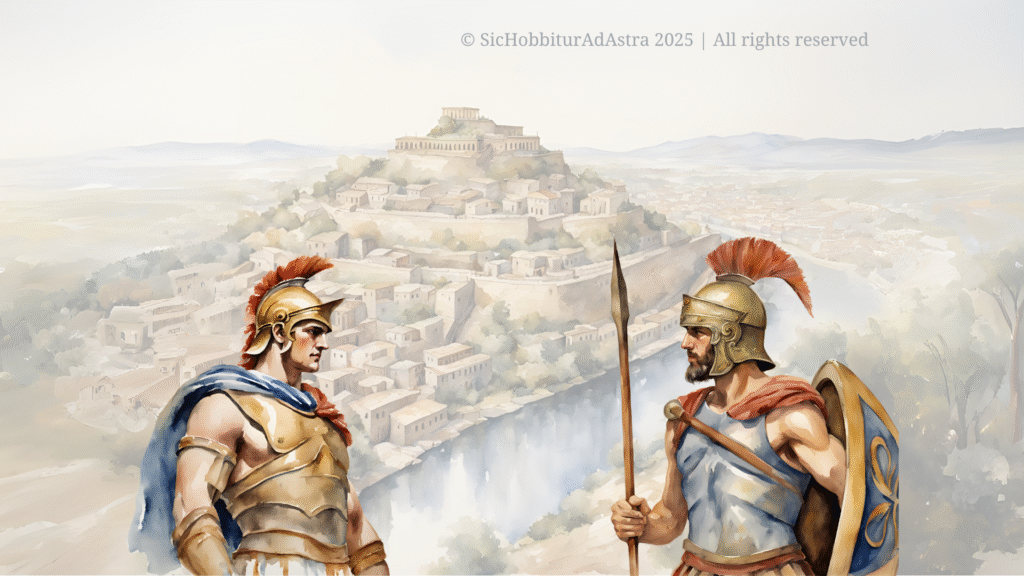
When you begin teaching the Iliad in class, a natural question arises: Where should I start? It’s a perfectly valid question given the vast scope of the poem, its dense mythology, many characters, historical context, and cultural distance.
Personally, I like to start with the physical book itself — holding the Iliad in my hands in all its grandeur, showing it to students. This simple act helps answer the initial question: we begin with the very first word on the cover — Homer. Who was Homer? Did he really exist? What is the fascinating and long-standing “Homeric Question”? What was the Greek Dark Ages?
After briefly exploring these captivating topics (I’ve created a digital resource that walks through these questions step-by-step — you can find it below if interested), we move on to the second word: Iliad.
Here, it’s easy to get overwhelmed. How do we open students’ eyes to the greatness of this epic poem? How do we answer the deceptively simple question, “What is the Iliad about?”
Some teachers start with a character map, others with a summary of the Trojan War or an overview of the entire story. I prefer to begin with the text itself — not with the first scene, but with the very first word: “rage.”
“μῆνις”: How Much Iliad Is in One Word?
The original Greek text, always worth referring to, begins with the word “Μῆνις” (menis), meaning wrath or rage. This word opens not just the entire poem — signaling its importance — but also the proem, the opening section where fundamental themes are introduced. Starting with menis allows students to explore the poem’s central subject — its very heart and essence.
Answering “What is the Iliad about?” by saying it tells the story of the Trojan War is incomplete or even misleading. The Trojan War lasted ten years, but the Iliad covers only a short period — 51 days in the tenth year. It doesn’t describe the war’s beginnings, early battles, or the famous ending with the Trojan Horse. Homer focuses on a very specific moment: the rage of Achilles.
This makes menis a crucial entry point for guiding students into the text. The Iliad isn’t simply about the Trojan War; it is about a very particular episode within it. To understand Homer’s message, it’s essential to start with this word — rage. A close, word-by-word analysis of the proem teaches students to read like philologists and thoughtful readers.
The Power of Achilles’ “μῆνις”
Achilles’ menis is not just a personal feeling — it is the narrative engine of the entire Iliad.
What does this word mean deeply? What is its etymology? Menis is a sacred and destructive rage, usually attributed to the gods. Homer’s choice is deliberate: it is not thymos (momentary anger) nor kholos (impulsive fury). That a mortal hero — Achilles — is described with divine wrath signals something vast beyond human measure.
The proem describes this wrath’s scope: an ira oulomenēn (“murderous, doomed”) that “muri’ Akhaiois alge’ ethēke” (“cost the Achaeans countless losses”), causing not private pain but collective suffering. Achilles’ wrath “polla isthimous psukhas Aidi proiapsen” (“hurled down to the House of Death so many sturdy souls, great fighters’ souls”), bringing death to Greek heroes and soldiers. The text states it “etheoria teukhe kinesis kai oionosi pansi” — “made their bodies carrion, feasts for the dogs and birds” — the brutal aftermath of war, leaving young heroes unburied.
Beginning here lets teachers ask concrete, relatable questions that connect students to Achilles’ rage, making an ancient word alive and relevant:
- What makes you deeply angry?
- What is anger that cannot be controlled?
- When does anger become destructive?
One benefit of teaching the Iliad with the proem is that students immediately engage with core themes like anger, honor, and mortality.
Why Was Achilles Angry?
Once students grasp Achilles’ devastating wrath through the text, the inevitable question arises: Why? What caused Achilles’ rage?
This is my favorite part. I ask students to put down their pens, get comfortable, and listen closely as I tell the story — from the wedding of Peleus and Thetis, to the Trojan War’s outbreak, the heroes’ involvement, and finally the conflict between Achilles and Agamemnon.
In my ten years teaching, I’ve never met a student who wasn’t fascinated. Even reluctant learners, if gently guided, begin to empathize with these mythological figures — their struggles, questions, and emotions.
This ancient yet compelling narrative reveals the Iliad’s core themes: individual vs. society, pride and resentment, wounded honor and revenge, consequences on others, Greek ideas of life after death, and longing for eternal remembrance.
Working on “μῆνις” in Class: From Proem to Student Notebooks
After unpacking the word’s meaning and the story behind it, I lead students in brainstorming to organize our exploration. I ask them to take notes and decide how to arrange the information in their notebooks.
Together, we build a philological analysis of menis, describe Achilles and other heroes, map Greek beliefs about the afterlife, honor, fate, and more.
Example notes:
-
“μῆνις”
- Translation: wrath, rage
- Connotations: sacred term, usually for gods; applied to mortal Achilles
- Narrative function: cause of the poem; signals hero’s conflict with world order
- Motivation: Agamemnon’s taking of Briseis, a war prize symbolizing honor
-
Achilles:
- Son of Peleus and Thetis, demigod, invulnerable except heel
- Prophecy: will die young, driving pursuit of glory
- Hid on Skyros to avoid war, found by Odysseus
- Angry at Agamemnon for taking Briseis — insult to honor, causes withdrawal from battle
In Conclusion: Starting with the Text Is a Powerful Teaching Choice
Beginning with a word-by-word analysis of the proem does more than read an ancient poem — it leads students into a worldview. The Iliad speaks to emotions still burning today: pride, offense, loss, revenge, compassion.
Starting from menis invites students to engage with a word that triggered devastating events. Words aren’t neutral; they tell stories, shape realities, create worlds. Epic poetry is a profound human experience.
This approach helps students become true philologists — reading Homer deeply, practicing critical thinking and linguistic analysis, entering the Greek worldview through language, and connecting ancient and present through timeless passions.
Plus, this close reading can be repeated with every important word: “ἀείδε” (sing), “θεά” (goddess), “Πηληϊάδεω” (son of Peleus), each unlocking layers of meaning and engaging students deeply.
Interested in Bringing This Activity to Your Classroom?
If you’re interested in teaching the Iliad with the proem, I’ve created a comprehensive digital resource with step-by-step guidance, no prep needed.
It includes:
- A line-by-line worksheet of the proem, with linguistic, morphological, and semantic analysis
- Detailed lessons on key words (not just menis!)
- Guided activities for individual or group analysis
- A teacher’s guide with discussion prompts, reflection questions, and interdisciplinary connections
This resource reflects ten years of teaching experience and is perfect for middle and high school classes or introductory classical studies. It offers a rigorous and passionate way to start teaching this epic poem. This digital resource is also part of a larger teaching bundle that includes everything you need to guide your students through the Iliad step by step. You can find it here.
What do you think of this approach to introducing literary works?
I’d love to hear your thoughts in the comments!
Meanwhile, happy teaching!
Chiara



